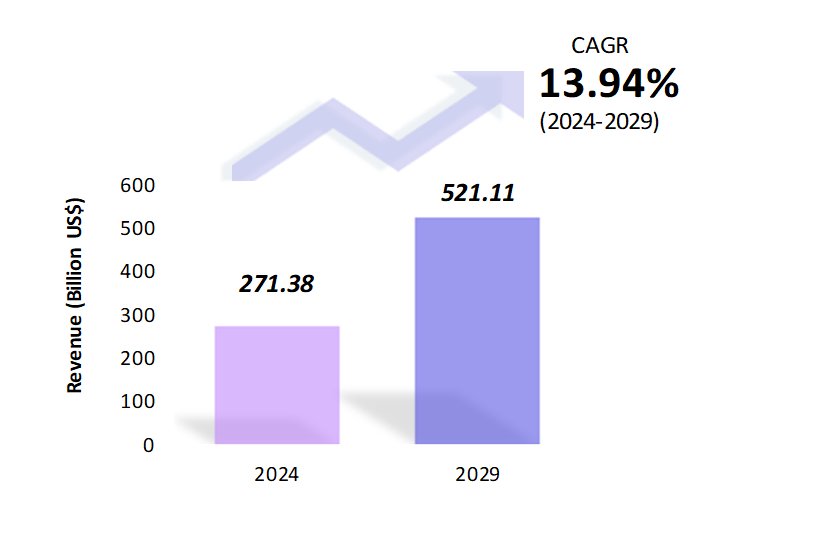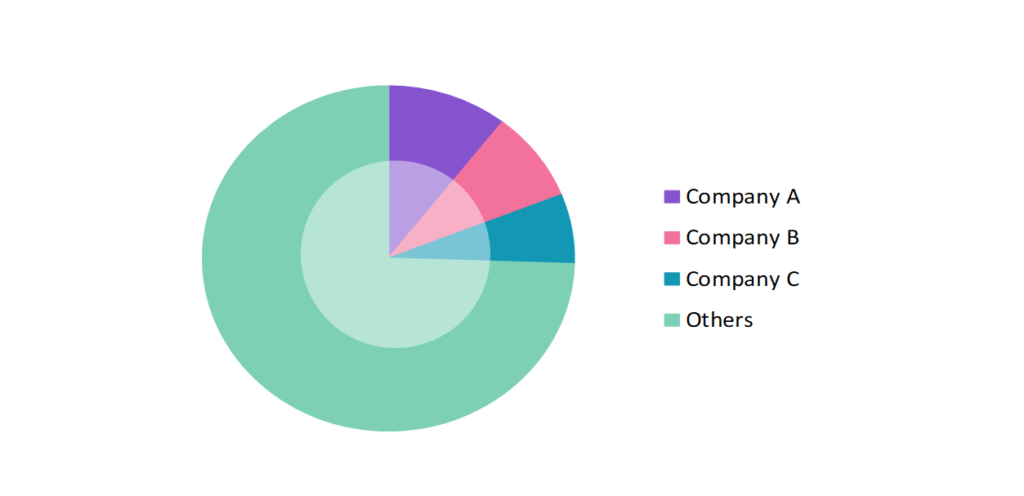Big Data Market: Size, Share, Trends & Forecast (2024-2029)
The market report offers a detailed analysis segmented by Component (Hardware, Software, Services); by Business Function (Marketing & Sales, Human Resources, Operations, Finance & Accounting, Others); by Data Type (Unstructured Data, Semi-Structured Data); by Vertical (BFSI, Telecommunication, Retail & Consumer Goods, Healthcare & Lifesciences, Government & Defense, Automotive, Education, Others); by Geography (North America, South America, Asia Pacific, Europe, The Middle East, Africa)
Market Dimensions & Growth Potential

- The big data market is estimated to be at USD 271.38 Bn in 2024 and is anticipated to reach USD 521.11 Bn in 2029.
- The big data market is registering a CAGR of 13.94% during the forecast period of 2024-2029.
- The big data market is characterized by its rapid growth, driven by the exponential increase in data volume from various sources such as IoT devices, social media, and digital transactions.
Request a free sample.
Competitive Landscape & Market Positioning in 2023

- The participants in the global big data industry are always developing their strategies to preserve a competitive advantage.
- These companies primarily use acquisitions, R&D, partnerships, and technological launches.
- Several important entities in the big data market include International Business Machines Corp.; Oracle Corp.; Microsoft Corp.; SAP SE; Salesforce, Inc.; and others.
Ask for customization.
Report Objectives & Insights
| Attributes | Values |
| Historical Period | 2018-2022 |
| Base Year | 2023 |
| Forecast Period | 2024-2029 |
| Market Size (2024) | USD 271.38 Bn |
| Market Size (2029) | USD 521.11 Bn |
| Growth Rate | 13.94% CAGR from 2024 to 2029 |
| Key Segments | Component (Hardware, Software, Services); Business Function (Marketing & Sales, Human Resources, Operations, Finance & Accounting, Others); Data Type (Unstructured Data, Semi-Structured Data); Vertical (BFSI, Telecommunication, Retail & Consumer goods, Healthcare & Lifesciences, Government & Defense, Automotive, Education, Others); Geography (North America, South America, Asia Pacific, Europe, The Middle East, Africa) |
| Key Vendors | International Business Machines Corp.; Oracle Corp.; Microsoft Corp.; SAP SE; Salesforce, Inc. |
| Key Countries | The US, Canada, Mexico, Germany, France, The UK, Russia, Italy, China, Japan, Korea, India. |
| Largest Market | North America |
Get a free quote.
Market Trends & Future Outlook
- Edge Computing Enhances Big Data Market Dynamics: Edge computing is transforming the big data market by enabling real-time data processing closer to the source, reducing latency and bandwidth costs. This advancement supports rapid, actionable insights and improves operational efficiency.
- Integration of AI (Artificial Intelligence) And ML (Machine Learning): AI and ML enhance data analysis capabilities, enabling predictive analytics, real-time data processing, and advanced pattern recognition, which drive more informed decision-making and operational efficiencies. For instance, the Mount Sinai Health System in New York has implemented an AI-powered platform called the Mount Sinai Clinical Intelligence Center (MSCIC). This platform leverages big data analytics and ML algorithms to analyze vast amounts of patient data in real-time.
- Proliferation of Internet of Things (IoT) devices: The proliferation of Internet of Things (IoT) devices has also fueled the growth of big data, as these devices generate massive volumes of data that need to be collected, stored, and analyzed. This trend underscores the increasing demand for advanced data storage and processing solutions.
Speak to analyst.
Key Market Influencers & Growth Drivers
- Real-Time Analytics Demand Boosts Big Data Market: The increasing need for real-time analytics is a key driver in the big data market. Businesses seek to leverage instant insights for better decision-making and competitive advantage. This demand is fueling investments in advanced data processing technologies and infrastructure.
- Democratization: A notable driver in the big data market is “democratization,” which involves making analytics accessible to a broader range of frontline users rather than just statistics experts. These users can integrate data from multiple sources, including external ones, and conduct predictive analytics without writing code. Companies like American Express, Procter & Gamble, and Walmart have invested significantly in these technologies to democratize the use of analytics, enabling frontline users to leverage data for addressing business challenges and making informed decisions.
- Managing Unstructured Data: The exponential growth in company data, driven by technological advancements and the lower costs of smart devices, results in a substantial volume of structured and unstructured data. Most of this data isn’t stored in traditional relational databases but instead resides in sources like social media posts, machine logs, images, and other unstructured formats. Managing this vast and diverse data landscape poses challenges for many organizations. In today’s era of cloud computing, big data solutions are indispensable for businesses of all sizes to effectively handle and analyze their data.
Inquire before buying.
Market Obstacles & Growth Barriers
- Complexity of managing and analyzing extensive data from diverse sources: One significant challenge is the complexity of managing and analyzing vast amounts of data generated from diverse sources. For instance, organizations struggle to integrate and harmonize data from structured databases and unstructured sources like social media, IoT devices, and machine logs. This complexity often requires sophisticated data management solutions and skilled data professionals.
- Data Privacy and Security Compliance: Another challenge is ensuring data privacy and security in compliance with regulations such as the General Data Protection Regulation (GDPR) and the California Consumer Privacy Act (CCPA). Companies must implement robust data governance frameworks and security measures to protect sensitive information from breaches and unauthorized access. For example, the healthcare and financial sectors handle sensitive personal data and face stringent regulatory requirements, necessitating advanced encryption and access control measures.
- Requirement of Advanced Analytical Capabilities: Extracting meaningful insights from big data requires advanced analytics capabilities. Organizations need sophisticated AI and machine learning tools to perform predictive analytics and derive actionable insights. For instance, retail companies use predictive analytics to forecast customer demand and optimize inventory management.
Personalize this research.
Map Highlighting Key Region in 2023

Explore purchase options.
Table of Contents
| 1. Introduction |
|---|
| 1.1. Research Methodology |
| 1.2. Scope of the Study |
| 2. Market Overview / Executive Summary |
| 2.1. Global Big Data Market (2018 – 2022) |
| 2.2. Global Big Data Market (2023 – 2029) |
| 3. Market Segmentation |
| 3.1. Global Big Data Market by Component |
| 3.1.1. Hardware |
| 3.1.2. Software |
| 3.1.3. Services |
| 3.2. Global Big Data Market by Business Function |
| 3.2.1. Marketing & Sales |
| 3.2.2. Human Resources |
| 3.2.3. Operations |
| 3.2.4. Finance & Accounting |
| 3.2.5. Others |
| 3.3. Global Big Data Market by Data Type |
| 3.3.1. Unstructured Data |
| 3.3.2. Semi-Structured Data |
| 3.4. Global Big Data Market by Vertical |
| 3.4.1. BFSI |
| 3.4.2. Telecommunication |
| 3.4.3. Retail & Consumer goods |
| 3.4.4. Healthcare & Lifesciences |
| 3.4.5. Government & Defense |
| 3.4.6. Automotive |
| 3.4.7. Education |
| 3.4.8. Others |
| 4. Regional Segmentation |
| 4.1. North America |
| 4.1.1. The US |
| 4.1.2. Canada |
| 4.1.3. Mexico |
| 4.2. South America |
| 4.2.1. Brazil |
| 4.2.2. Argentina |
| 4.2.3. Colombia |
| 4.2.4. Chile |
| 4.2.5. Rest of South America |
| 4.3. Asia Pacific |
| 4.3.1. China |
| 4.3.2. India |
| 4.3.3. Japan |
| 4.3.4. South Korea |
| 4.3.5. Rest of Asia Pacific |
| 4.4. Europe |
| 4.4.1. The UK |
| 4.4.2. Germany |
| 4.4.3. Italy |
| 4.4.4. France |
| 4.4.5. Spain |
| 4.4.6. Rest of Europe |
| 4.5. The Middle East |
| 4.5.1. Turkey |
| 4.5.2. UAE |
| 4.5.3. Saudi Arabia |
| 4.5.4. Rest of the Middle East |
| 4.6. Africa |
| 4.6.1. Egypt |
| 4.6.2. South Africa |
| 4.6.3. Rest of Africa |
| 5. Value Chain Analysis of the Global Big Data Market |
| 6. Porter Five Forces Analysis |
| 6.1. Threats of New Entrants |
| 6.2. Threats of Substitutes |
| 6.3. Bargaining Power of Buyers |
| 6.4. Bargaining Power of Suppliers |
| 6.5. Competition in the Industry |
| 7. Trends, Drivers and Challenges Analysis |
| 7.1. Market Trends |
| 7.1.1. Market Trend 1 |
| 7.1.2. Market Trend 2 |
| 7.1.3. Market Trend 3 |
| 7.2. Market Drivers |
| 7.2.1. Market Driver 1 |
| 7.2.2. Market Driver 2 |
| 7.2.3. Market Driver 3 |
| 7.3. Market Challenges |
| 7.3.1. Market Challenge 1 |
| 7.3.2. Market Challenge 2 |
| 7.3.3. Market Challenge 3 |
| 8. Opportunities Analysis |
| 8.1. Market Opportunity 1 |
| 8.2. Market Opportunity 2 |
| 8.3. Market Opportunity 3 |
| 9. Competitive Landscape |
| 9.1. International Business Machines Corp. |
| 9.2. Oracle Corp. |
| 9.3. Microsoft Corp. |
| 9.4. SAP SE |
| 9.5. Salesforce, Inc. |
| 9.6. Company 6 |
| 9.7. Company 7 |
| 9.8. Company 8 |
| 9.9. Company 9 |
| 9.10. Company 10 |
Know the research methodology.
Big Data Market – FAQs
What is the current size of the big data market?
In 2024, the big data market size is $271.38 Bn.
Who are the major vendors in the big data market?
The major vendors in the big data market are International Business Machines Corp.; Oracle Corp.; Microsoft Corp.; SAP SE; Salesforce, Inc.
Which segments are covered under the big data market segments analysis?
The big data market report offers in-depth insights into Component, Business Function, Data Type, Vertical, and Geography.
